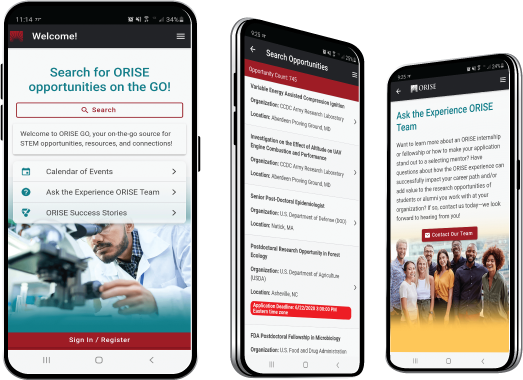EPA Chesapeake Bay Watershed Hydrologic and Water Quality Modeler Fellowship
- An application
- Transcript(s) – For this opportunity, an unofficial transcript or copy of the student academic records printed by the applicant or by academic advisors from internal institution systems may be submitted. All transcripts must be in English or include an official English translation. Click here for detailed information about acceptable transcripts.
- A current resume/CV, including academic history, employment history, relevant experiences, and publication list
- Two educational or professional recommendations. Click here for detailed information about recommendations.
*Applications may be reviewed on a rolling-basis and this posting could close before the deadline. Click here for information about the selection process.
EPA Office/Lab and Location: A research opportunity is available with the Environmental Protection Agency (EPA), Region 3 within the Chesapeake Bay Program Office (CBPO) located in Annapolis, Maryland.
Research Project: The Chesapeake Bay Program Office (CBPO) of U.S. EPA Region 3 is seeking a candidate with education and experience in hydrologic and water quality modeling to conduct research on the next generation Chesapeake Bay Program Partnership’s Watershed Model (CBP Watershed Model). The candidate will conduct research alongside an established team of model practitioners at CBPO who are working on projects involving the development and application of numerical models and statistical analyses to support the historic Chesapeake Bay nutrient and sediment Total Maximum Daily Load (TMDL). It includes the state-of-the-art simulation of watershed processes controlling the delivery of water, sediment, nitrogen, and phosphorus at different temporal and spatial scales. The research will also require extensive interaction and collaboration with managers, scientists, and engineers throughout the Chesapeake Bay Program Partnership, including different academic institutions and scientific organizations.
The structure of the CBP Watershed Model is a combination of time-averaged and dynamic models that harness the power of both statistical and process modeling and are applied at multiple spatial scales. The CBP is working on a substantial update to these models in preparation for collective decision-making in 2027. Improvements will be made to both input data and watershed processes. Newly available types of data such as high-resolution land use, topography, hydro-geography, and monitoring provide an opportunity to identify emergent watershed characteristics to enhance the model, to improve predictions of watershed conditions, and to identify critical source areas on the landscape for better targeting of management and restoration efforts. The successful applicant will have the opportunity to further their scientific and creative skills by directly contributing to designing and developing modeling and data analysis approaches instrumental to the improvement of the world class and cutting edge CBP models.
The appointment will be located at CBPO but may involve collaboration with investigators at other locations.
Specific Research Topics and Tasks:
- Understanding of fine-scale hydro-geomorphological data in the context of a management model.
- Identification of emergent watershed properties for a fine-scale time-averaged model of hydrologic processes, and the delivery potential of nutrients and sediment.
- Identification of essential watershed processes and methods for a medium-scale dynamic watershed model predicting hourly flow, nutrients, and sediment transport.
- Statistical modeling of landscape and anthropogenic features to support management models.
- Literature reviews of watershed processes and modeling techniques to support model-building.
- Investigation of climate change effects to improve scientific foundation of the management model.
- Study of source loads and methods for developing model inputs representing phenology, particularly those with relevance and importance to climate change impacts.
- Interpretation of model outputs to effectively communicate research findings with scientists and managers.
- Communications with scientists and stakeholders through written documents and presentations.
- Publication of peer-reviewed articles.
Learning Objectives: The next generation of the Chesapeake Bay Watershed Model will allow for prediction of nutrient and sediment processes at a finer spatial scale. The combined strengths of statistical and mechanistic approaches will be used to produce a management/scientific model that is responsive to stakeholder needs. The watershed modeler will join an experienced modeling and analysis team at the Chesapeake Bay Program Office in Annapolis, Maryland to support research needed to develop, calibrate, and apply such a regional scale model. Deep collaboration with scientists, modelers, and stakeholders throughout the Chesapeake region will help in identifying the needs and further strengthen the scientific basis of the modeling. The research will be applied to the effects of climate change, future growth, and other challenges to Chesapeake water quality and living resources. Results will be conveyed through multiple conference and stakeholder presentations, formal model documentation, and peer-reviewed articles.
Mentor(s): The mentor for this opportunity is Lewis Linker (linker.lewis@epa.gov). If you have questions about the nature of the research, please contact the mentor(s).
Anticipated Appointment Start Date: July 2023. All start dates are flexible and vary depending on numerous factors. Click here for detailed information about start dates.
Appointment Length: The appointment may initially be for one year and may be renewed upon EPA recommendation and subject to availability of funding.
Level of Participation: The appointment is full-time.
Participant Stipend: The participant will receive a monthly stipend commensurate with educational level and experience. Click here for detailed information about full-time stipends.
EPA Security Clearance: Completion of a successful background investigation by the Office of Personnel Management (OPM) is required for an applicant to be on-boarded at EPA.
ORISE Information: This program, administered by ORAU through its contract with the U.S. Department of Energy (DOE) to manage the Oak Ridge Institute for Science and Education (ORISE), was established through an interagency agreement between DOE and EPA. Participants do not become employees of EPA, DOE or the program administrator, and there are no employment-related benefits. Proof of health insurance is required for participation in this program. Health insurance can be obtained through ORISE.
ORISE offers all ORISE EPA graduate students and Postdocs a free 5 year membership to the National Postdoctoral Association (NPA).
The successful applicant(s) will be required to comply with Environmental, Safety and Health (ES&H) requirements of the hosting facility, including but not limited to, COVID-19 requirements (e.g. facial covering, physical distancing, testing, vaccination).
Questions: Please see the FAQ section of our website. After reading, if you have additional questions about the application process, please email ORISE.EPA.REG@orau.org and include the reference code for this opportunity.
The qualified candidate should have received a master's or doctoral (preferred) degree in one of the relevant fields, or be currently pursuing a doctoral degree with completion before the appointment start date. Degree must have been received within five years of the appointment start date.
Preferred qualifications:
- Earned PhD in a relevant field or MS with equivalent experience.
- Understanding of hydrologic, sediment, nitrogen, and phosphorus processes
- Experience with process-based modeling.
- Experience with statistical modeling.
- Strong geospatial analysis skills for modeling
- Ability to manipulate, analyze, interpret, and display watershed data.
- Programming experience in multiple languages/platforms.
- Strong written and verbal communication skills.
- Experience with multiple types of computationally intensive, process-based and empirical models.
- Evidence of experience in interdisciplinary collaboration.
- Citizenship: U.S. Citizen Only
- Degree: Master's Degree or Doctoral Degree received within the last 60 months or currently pursuing.
- Discipline(s):

 ORISE GO
ORISE GO

The ORISE GO mobile app helps you stay engaged, connected and informed during your ORISE experience – from application, to offer, through your appointment and even as an ORISE alum!





